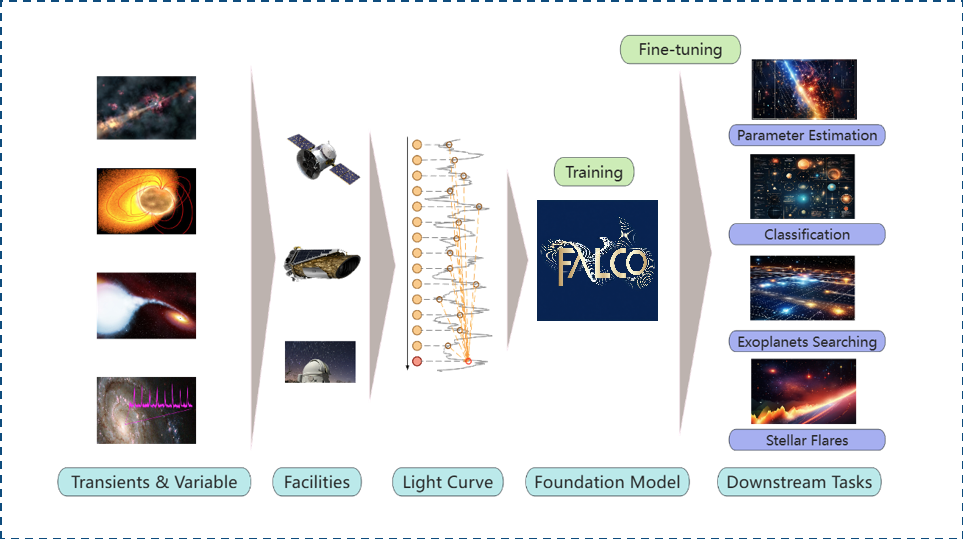FALCO时域光变大模型介绍 FALCO Introduction
2025-01-17
天文学是人类探索和认识宇宙的基础学科,而观测则是推动天文学不断前行的核心动力。随着望远镜和探测器技术的飞速发展,从早期的单张黑白照片到真彩色的连续拍摄,再到超大规模时域巡天致力于打造的“宇宙彩色记录机”,人类正以前所未有的方式与速度凝望星空。技术革新使时域天文学成为当今发展最快的天文学前沿领域之一。通过观测天体亮度随时间的变化,天文学家得以揭示宇宙中丰富而复杂的动态过程。
大规模时域巡天项目的开展为天文学研究带来了前所未有的机遇,同时,时域天文学对快速响应的需求,也对海量数据的高效处理与精准分析提出了严峻挑战。
目前,针对特定类型天体或任务开发的小型模型往往缺乏通用性,难以扩展应用到其他研究场景。而近年来人工智能和基础模型的蓬勃发展,为时域天文研究开辟了新的思路。在此背景下,我们研发了时域光变大模型FALCO。FALCO模型基于Transformer架构,首发版本参数量约1.4B,使用Kepler观测的光变数据进行了自监督训练,旨在理解各类天体的光变特征,并实现参数预测和事件检测,为时域天文研究提供支持。
FALCO模型现已在变星分类、恒星表面重力参数(log g)估计、恒星耀发检测等方面取得了优异效果。同时,模型具备适应更多任务的能力。未来,我们将持续优化模型性能,探索更多应用场景和下游任务,致力于协助天文学家全面分析处理时域天文数据,为揭示宇宙动态演化规律开辟新的途径。
Astronomy is a foundational discipline for exploring and understanding the cosmos, with observational capabilities driving its advancement. The rapid evolution of telescope and detector technologies—from early single monochrome exposures to continuous full-color imaging, to large-scale time-domain surveys creating a cosmic chromatic recorder—has transformed our observational paradigm. These technological innovations have established time-domain astronomy as one of the fast-growing frontiers in modern astrophysics. By analyzing photometric brightness variations over time, astronomers can reveal the diverse and complex dynamical processes throughout the universe.
While large-scale time-domain survey projects provide unprecedented opportunities for astronomical research, the requirement for rapid response presents significant challenges for efficient processing and precise analysis of massive datasets.Current specialized models developed for specific celestial objects or tasks typically lack generalizability and are difficult to extend to broader research contexts. However, recent advances in artificial intelligence and foundation models have opened new avenues for time-domain astronomical research.
We developed FALCO, a Foundation model of Astronomical Light Curves for time dOmain astronomy. Based on the Transformer architecture with approximately 1.4 billion parameters, FALCO's initial release was trained using self-supervised learning on Kepler light curve data. The model aims to comprehend photometric variation characteristics across diverse celestial objects, enable parameter inference and transient detection, and support time-domain astronomical research.
FALCO has already demonstrated excellent performance in variable star classification, stellar surface gravity (log g) estimation, and stellar flare detection. The model also exhibits adaptability to additional astronomical tasks. We will continuously enhance model capability, explore additional applications and science applications, and strive to assist astronomers in comprehensive analysis of time-domain astronomical data, opening new pathways for understanding cosmic dynamical evolution.
